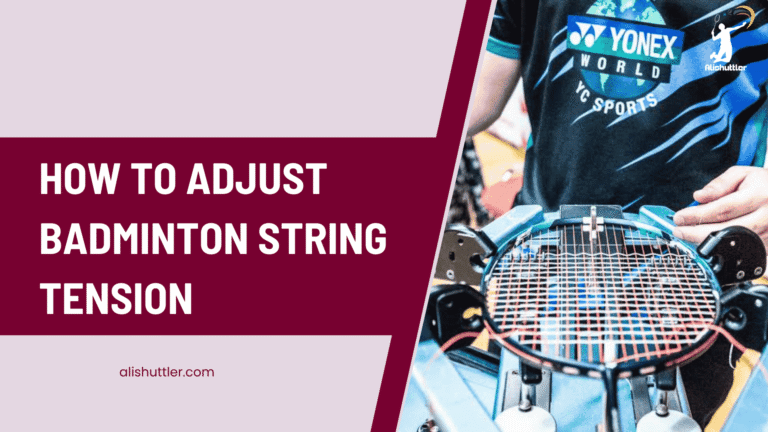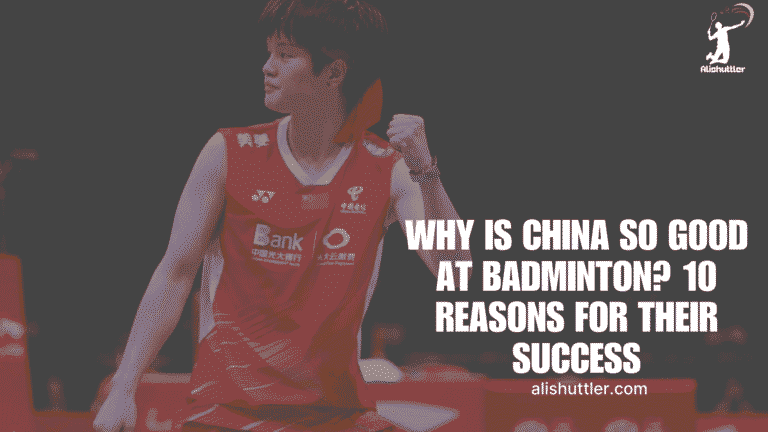Rules of badminton singles to make games competitive and safe. Each team consists of a single player, and the court employs the inner sidelines. A singles match starts with a coin toss to decide which player serves first.
As the one serving, they are responsible for making sure the ball goes over the short service line. Players earn one point per rally they win. Games are only to 21 points, oh wait, you have to win by two!
If both go to 20, play continues until one player is ahead by two points, with a maximum of 30. The size of a singles court is 17 feet wide x 44 feet long. These regulations influence player tactics, types of serves, and scoring methods in each match.
The following chapters explain the most important Badminton Rules for Singles in depth and provide advice for beginners and more experienced players alike.
What Is Singles Badminton?

Singles badminton is an intense, head-to-head competition, pitting one athlete against another with each side fighting individually to score points. The overall format may be basic, but the sport itself is an ultimate challenge of skill, speed, and mental fortitude.
Unlike doubles, singles places the responsibility of the entire court on each individual player. In the U.S., that court is 44 feet long and 17 feet wide. The goal stays the same: hit the shuttlecock over the net and land it inside your opponent’s half.
This format is extremely popular in major competitions such as BWF World Championships and Olympic Games. Here, elite players demonstrate more than just raw speed, quick reflexes and crafty play. A singles match requires powerful legs, lightning quick feet, and the sharpest of minds.
Beyond the court each player has to constantly anticipate the opponent’s game and make lightning quick decisions while managing the nerves and pressure.
Singles vs. Doubles: Key Differences
Singles has one player on each side as opposed to doubles, where there are two players on each side. In singles, each player is responsible for all the court space, resulting in greater rally lengths and a greater need for speed.
In doubles, partners divide the court, resulting in faster, but less physically endurance-requiring play. Both singles and doubles utilize a rally point scoring system, but singles matches tend to be more drawn out, thanks to the slower tempo of play.
Singles players develop designs individually, but doubles requires collaboration.
Why Singles Play Is Unique
It’s all about stamina and endurance. Athletes sprint from baseline to baseline and corner to corner, putting every shot with precision and intent. Control is important because each point is decided by the best individual decision maker.
The mental aspect is equally challenging—playing singles you have no one to share or deflect pressure with. It’s up to each player to formulate a game plan and adapt in real-time.
The Spirit of Singles Play
At its best, singles badminton is an exhilarating match of intent and technique. Players appreciate each other’s competitive spirit and work ethic.
Good sportsmanship is what allows for clean and competitive matches. Success is deeply personal and hard-fought.
The Singles Badminton Court

The singles badminton court is quite a bit smaller than the doubles version. It’s just as long as a singles court at 20 feet wide, but still 44 feet long. The lines, zones, and court elements determine how each point is played. Understanding the inner workings lays the foundation for every player to move more intelligently and play more effectively.
The court has a unique short service line, which is located 6 feet 6 inches from the net. The center line divides the width of the court into two equal halves. The double service line shows the back boundary, and two inner sideline lines establish the width for singles. These lines determine which part of the court the shuttle needs to land on during rallies and serves.
The players stretch each side, running, lunging, reaching with incredible athleticism from side to side. The hard floor or mat, wind, and even lighting can shift the flow of a match, especially in local LA gyms or outdoor setups.
Rules changes allow the game to remain competitive and relevant. According to the rules, players change sides after each set and once someone gets 11 points in a rubber match of sorts, a third game. This exchange is an important part of combating the impact of variable terrain, wind, or sunlight glare.
Singles Court Lines Explained
We’ve established that lines have very specific, very important jobs. The short service line also determines where your serves must land. The center line separates the serve zones. The long service line and the inside sidelines create the space for play.
With a single line missed, you lose the point. These lines define the way players are forced to move, requiring extreme changes of direction and angles.
Net Height and Setup
The top of the net should be 5 feet at the center, 5 feet 1 inch at the posts. An improperly tightened or sagging net can destroy all sense of fair play. Net height influences your choice of shot—higher nets force more lifts, lower nets lead to more tight net shots.
How Lines Affect Your Game
Understanding court lines improves footwork and shot accuracy. Good line judgement helps you improve your footwork and shot precision. This is very useful because it helps you identify a lot of open spaces.
Too often players lose the opportunity by failing to look at where they are, resulting in simple mistakes that are easily preventable.
My Tip: Use Court Wisely
Tip #3 — Create good angles and avoid the sides and corners. Work on your drop shots and clears to each side of the court. Be in the middle whenever you can, prepared to move to cut off court.
My Tip: Use the court to your advantage. Build your plan based off the court’s dimensions and shape.
Mastering Singles Badminton Rules

Knowing the singles badminton rules are essential for players who wish to be competitive or simply play the game with proficiency. The criteria outlined above dictate the rhythm of the match, what players do on court, and how each point is earned or dropped. Understanding what these rules entail goes beyond just not getting called for a fault.
It enables players to make more intelligent decisions and to derive greater value from each match. In the U.S., the game is played according to established regulations, ensuring that all players can expect a fair and safe play environment. Arbitrators are present to ensure players adhere to the regulations, protecting all competitors’ interests.
So with that in mind, here is a short breakdown of the basic rules and their application during real-life play.
1. Starting the Game: The Toss
Before the match begins with the first serve, a toss determines who serves first. This easy action determines who will serve first, or which side of the court each player will begin on. Winning the toss provides just a slight advantage.
The winner has the choice to serve first or choose a side of the court, with the other player then choosing the remainder. As an example, if the winner selects to serve first, the opponent decides what side to begin on. This becomes very important if one half of the gym has better lighting conditions or less wind draft.
Great tacticians will take advantage of the toss to force their opponent to face their strengths. They come out with their premier serve or choose the side that has more shadow. This prevents any confusion by maintaining clear, direct communication with your opponent and referee throughout the toss.
This method ensures that every game is fair right from the beginning!
2. Scoring Points: Rally System
Badminton singles matches employ a rally scoring system. This implies that a point is scored on each rally, regardless of who is serving. In order to win a game, a player must get to 21 points.
They must win by at least 2 points (such as winning 21-19). If it’s 20-20, you continue playing until one player has a 2-point advantage. Points can be scored when the shuttlecock drops on the opponent’s side of the court, so this includes all outer lines in singles.
Because each rally counts, players must be focused and prepared at all times. The relentless-attack nature of rally scoring makes sharp concentration and calm, collected composure invaluable commodities. A match is typically the best of three games.
Making sure you stay energized and engaged over the course of the whole event is super important!
3. Serving Correctly in Singles
Serving in singles has stringent regulations. First, the server always needs to be in the proper server’s box and serve into the opponent’s diagonal service box. The serve should be done with the racket hitting the shuttlecock below the server’s waist.
In the U.S., waist is considered the lowest rib, and the badminton serve contact point must be below 1.15m or roughly 45 inches. Pay attention to where the server’s feet are placed, as they must not touch any of the lines while serving!
If you serve from the wrong box, it’s an automatic fault. According to the rules, lifting a foot off the floor before striking the shuttle is a fault! Players incorrectly lose points by serving too high or not making it to the diagonal box.
They are punished for hurrying and flouting the footwork regulation. To prevent these, it’s best to rehearse the same process with every serve and confirm your position before going into serving motion.
4. Receiving the Serve Legally
For the receiver, rules are easy yet very stringent. The receiver has to stay within the appropriate service box and can’t even leave it until after the server strikes the bird. Moving early or being out of bounds on serve reception is a fault.
The best receivers stay low, with the weight centered and ready to explode in any direction. The most effective returns are results of a quick half-second judgement of the type of serve, be it high, short, or to the rear.
A major error is anticipating the direction of the serve too early, disrupting balance. Being relaxed and tracking the shuttle to the very last moment will help you considerably.
5. Common Faults to Avoid
Every player is susceptible to faults, but understanding the most common faults in singles badminton allows you to eliminate the simple mistakes. In singles, players can fault by hitting the shuttle out of bounds or not returning it over the net.
They serve out of order, jump the gun as a receiver, or double-hit the shuttlecock! Touching the net with the body or racket or crossing under the net and stepping over the lines are faults as well. Every fault awards the other player a point, which can change the match in an instant.
To avoid faults, players must pay attention to light footwork, clean arcs on the racquet, and a calm disposition. After a fault, accepting the outcome, taking a deep breath, and resetting will help prevent a downward spiral into additional errors.
6. Understanding Lets (Replays)
A let is a replay, called when anything hinders proper play. For example, a shuttle can get caught in the net on a serve. It can be due to external interference or a blatant error on the part of the umpire.
When a let occurs, the point is played over with no score adjustment. Lets disrupt the momentum and replays can alter an opponent’s groove. This is useful for players because they shouldn’t get hot and allow a let to cause them to lose their concentration.
Whatever it is, being prepared for every eventuality helps you stay focused and helps you stay injury-free.
7. Player Positioning During Play
Good court placement matters a lot in singles. Being closer to the middle after every return allows you to get to the next shot more efficiently. Whether you’re getting too close to the net or hanging out in the back, there are huge holes you’re exposing yourself to.
Each shot needs to be aware of offensive and defensive play. Retreat to the mid-court position after a clear shot to the back. With this stance, you’re in a much better position to intercept a drop or a kill from the opponent.
Practicing footwork makes sure that your movements stay natural and swift, which will result in better shots and fewer errors.
Singles Service Rules Deep Dive

Singles badminton service rules heavily influence how points begin, and many times how rallies play out as well. Following these rules helps ensure the spirit of play remains competitive, and can be the difference between winning and losing a close game.
It’s these service judges that enforce these standards, ensuring that every serve is up to code.
Where to Stand When Serving
The server should stand in the right service court if their score is even, and the left if it’s odd. The feet must remain behind the singles service line, or roughly 13.5 feet from the net.
Having both feet remain on the ground until the shuttle is struck prevents this fault. Having good balance and a sound base of support is important.
Players that are properly positioned are less susceptible to losing their footing or hitting off center. Getting in the habit of performing the stance reinforces the muscle memory and helps form the routine, so the serve will feel identical each time.
Legal Serving Motion: My View
When making a serve, hit the shuttlecock under 3.8 feet for it to be considered valid. Not rounding the motion out is crucial.
Make sure your racket is going forward in one continuous, unbroken line. Snags, double pumps, or hitchy motions are a cause for a fault.
They tend to pull back too soon and hit too up, or stop, which allows for a loss of the serve. Consistent practice will make this motion good, clean and legal every time.
Service Faults: Don’t Get Caught!
Common pitfalls are to step on and or over the service line and to hit over the limit height. Players are too quick to not hit forward as well.
An opponent point, earned by a service fault, is a gift that quickly turns the momentum. Being aware of and practicing to avoid these mistakes keeps serves free and clear.
Service Strategy: An Edge
Changing between short and deep serves disrupts opponents’ rhythm and timing. Seeing their stance or return patterns can inform serve locations.
Being able to drill different serve types—high, low, flick—opens up choices, thus making the server more unpredictable.
Strategic Edge: Rules & Tactics

Understand all the rules in singles badminton. As with any formalized competitive sport, understanding the rules is essential. It really affects the way you go about playing, and it really gives you a strategic edge. The players who best understand the rules usually find opportunities others overlook. That understanding leads to better strategic decisions, improved tactical execution and ultimately superior performance on the court.
How Rules Shape Singles Strategy
Rules create opportunities and constraints with every action taken. Like a typical court for singles, it is 44 feet long and 17 feet wide. Unlike in doubles, the side alleys are out, which means that sharp cross-court shots and backhand clears become more effective.
As a result of the unique scoring system, a match is played to 21 points. You need to win by two points unless you get to 29-29, at which point the next point wins. This endangers players and forces them to maintain concentration in the closing moments of a match. Knowing when to switch ends—after each game and when a player scores 11 points in the third game—can shift momentum, especially if lighting or air flow in the gym differs.
Using Service Rules To Advantage
Smart serving is one of the biggest aspects of singles play. The server stands inside one of the service boxes, with the target of the serve being the opposite, diagonal service box. Changing your serve—short, flick or drive—makes your opponent think about their response.
For instance, if you alternate low serves with unexpected high serves, you can make it more difficult to predict returns. Quality service positioning, particularly near the sidelines, pushes the opponent into a time-crunch. It clears the court for your next shot!
Exploiting Court Boundaries Smartly
Tennis and badminton singles both favor players who can find the lines. The court’s dimensions make long clears or acute angles at the corners force your opponent to cover a lot of ground. It’s rewarding to practice these shots, but if you miss the boundaries or you hit too hard and go out of bounds, you’re losing valuable points.
Keeping track of your own position and court size is very important.
My Take: Outsmart Your Opponent
Wise moves score victories. Expect your opponent’s counter, change up the pace, and incorporate some misdirection. No matter how strong or smart you are, being able to read body language and keep your own composure will give you an undeniable advantage.
Rules Beyond the Official Handbook

Badminton singles match rules are very straightforward. Players often adopt habits and practices that go well beyond the official handbook. These loose rules, based around the communities developed by club culture, player knowledge, and mutual appreciation, keep the game free-flowing and equitable.
Knowing the written and unwritten rules creates more capable players of all ages. Whether they compete at an elite pro club, play in a local recreational facility, or practice in a collegiate complex, this understanding is crucial.
Pro vs. Local Club Interpretations
Rules that vary widely between jurisdictions can create confusion. For instance, pros may go back and forth at 11 game points in a third decider. Local clubs, on the other hand, can be content to adhere to switching ends after every game or not score at all with house rules for scoring.
Some clubs even have a rule that players look at the score before serving. As a corollary, they make players responsible for calling faults if the serve receiver leaves their position early. While not all of these practices are explicitly stated, they carry significant weight in how games are played.
Understanding how things are interpreted on the local level prevents misunderstanding and ensures matches remain competitive.
Handling On-Court Disagreements
Disagreements arise during high-scoring or low-scoring games or when plays are marginal. The vast majority of players resolve disputes through discussion and consensus. If you remain calm and assertive, most problems can be resolved.
When on-court disagreements rise to the level of altercations, referees will often intervene. Great clubs demand candid whistles and frank discussions, so all parties go home happy after the game.
Unwritten Rules: Sportsmanship Counts
Basic practices—such as self-officiating, taking turns, and shaking hands—improve everyone’s enjoyment of the game. Respecting your opponents and the officials goes a long way to establishing the trust necessary to maintain friendly play, even in highly competitive games.
Evolving Rules: What’s New?
Players are now playing to a set 30-point victory at 29-29. Don’t forget that they are supposed to know in advance which service box they should use at each score!
Club websites, electronic boards, and USA Badminton e-notices help everyone stay informed.
Badminton Singles Rules PDF Guide Easy to Download
Conclusion
Badminton rules for singles protect the integrity of the sport while making it exciting and competitive. The lines, the serve, the rallies—every element visually lays out the play and maintains the speed. Players need to serve from behind the line, play the bird, and look at the court’s narrow boundaries. Quick footwork and keen eyesight take the prize.
People in the U.S. Play on courts that are measured in feet, not meters, so each inch is important. You find every type of player, from yard game smashers to experienced club players. Whether you play near home or far from it, understanding these local ground rules allows you to play wisely while ensuring games run seamlessly and responsibly. Have the desire to improve your singles game? Pick up a paddle, get a workout in, and try out your new skills. You may be amazed at what you discover.
Frequently Asked Questions
What are the basic rules for singles badminton?
In singles badminton, the match is played between one player on each side. The match starts with a serve. You earn points in singles badminton by returning the shuttlecock over the net and into your opponent’s court. Rallies go on forever until the shuttle falls out or a mistake occurs.
What are the dimensions of a singles badminton court in the U.S.?
What are the dimensions of a singles badminton court in the U.S. In singles matches, only the inner sidelines are in play, resulting in a narrower court than that of doubles matches.
How is the serve different in singles compared to doubles?
In singles, the server serves diagonally across the court from their right service court when their score is even. When their score is even, they serve from the right side. All of the outer sidelines and two inner sideline boundary lines are in play for serving.
How do you win a singles badminton match?
The winners of a singles match is the best of three games to 21 points. You need to win by at least a two-point margin. The game is won when a player reaches the score of 21, unless both players are tied at 20-20.
What happens if the shuttlecock lands on the line?
Therefore, if the shuttlecock lands on the line, even a small fraction of it, it is counted in. Just like in doubles, this rule applies to all lines marking the singles court.
Can you touch the net in singles badminton?
The short answer is no, players can’t touch the net with their racket, body or clothing while the point is in play. If you do so, it’s a fault and you lose the point to your opponent.
What is a common singles strategy in badminton?
A very important singles strategy is to hit your opponent where you want them to go, requiring them to run back and forth across the court. This opens them up and can make them hit errors, putting you ahead.






